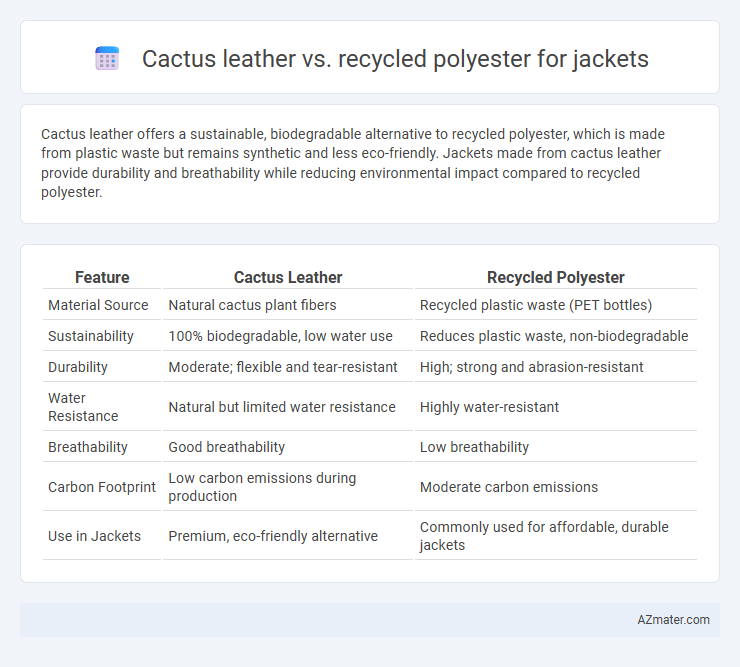Cactus leather offers a sustainable, biodegradable alternative to recycled polyester, which is made from plastic waste but remains synthetic and less eco-friendly. Jackets made from cactus leather provide durability and breathability while reducing environmental impact compared to recycled polyester.
Table of Comparison
| Feature | Cactus Leather | Recycled Polyester |
|---|---|---|
| Material Source | Natural cactus plant fibers | Recycled plastic waste (PET bottles) |
| Sustainability | 100% biodegradable, low water use | Reduces plastic waste, non-biodegradable |
| Durability | Moderate; flexible and tear-resistant | High; strong and abrasion-resistant |
| Water Resistance | Natural but limited water resistance | Highly water-resistant |
| Breathability | Good breathability | Low breathability |
| Carbon Footprint | Low carbon emissions during production | Moderate carbon emissions |
| Use in Jackets | Premium, eco-friendly alternative | Commonly used for affordable, durable jackets |
Introduction to Cactus Leather and Recycled Polyester
Cactus leather is an innovative, sustainable material made from mature leaves of the Nopal cactus, offering an eco-friendly alternative to traditional leather with durability and biodegradability. Recycled polyester, produced from post-consumer plastic waste such as PET bottles, reduces environmental impact by diverting plastic from landfills and lowering reliance on virgin petroleum resources. Both materials present eco-conscious choices for jacket manufacturing, balancing performance with sustainability.
Material Origins and Sustainability
Cactus leather is derived from mature cactus leaves, utilizing a natural, renewable plant source that requires minimal water and no harmful chemicals, making it highly sustainable. Recycled polyester is produced from post-consumer plastic waste, such as PET bottles, reducing landfill pollution and the demand for virgin petroleum-based materials but still involves energy-intensive processes. Both materials offer eco-friendly alternatives for jacket manufacturing, with cactus leather emphasizing plant-based renewability and recycled polyester focusing on waste reduction and circular economy principles.
Environmental Impact Comparison
Cactus leather offers a highly sustainable alternative to traditional materials, as it is biodegradable, requires minimal water, and produces fewer greenhouse gases during production compared to recycled polyester. Recycled polyester, while reducing plastic waste by repurposing PET bottles, still relies on fossil fuels and contributes microplastic pollution during washing. Choosing cactus leather significantly lowers environmental impact by combining durability with eco-friendly cultivation and processing methods, making it a superior option for environmentally conscious jacket manufacturing.
Durability and Longevity
Cactus leather offers a durable and flexible alternative to traditional materials, featuring natural resistance to wear and tear that enhances jacket longevity. Recycled polyester, engineered from plastic waste, provides strong resistance to abrasion and moisture, ensuring sustained durability under various weather conditions. Both materials contribute to eco-friendly outerwear, but cactus leather excels in biodegradability while recycled polyester outperforms in water resistance.
Comfort and Wearability
Cactus leather offers superior breathability and natural moisture-wicking properties compared to recycled polyester, enhancing comfort during extended wear. Its flexible texture adapts well to body movement, reducing stiffness often associated with synthetic fabrics. Recycled polyester jackets may lack the same level of breathability but are generally more water-resistant and easier to maintain, making them suitable for varied weather conditions.
Style and Aesthetic Versatility
Cactus leather offers a luxurious, natural texture that enhances the visual appeal of jackets with a sophisticated, eco-friendly look, suitable for both casual and formal styles. Recycled polyester provides a sleek, smooth finish with high color retention and varied patterns, making it ideal for versatile, urban-inspired fashion. Both materials enable designers to create stylish, sustainable jackets that cater to diverse aesthetic preferences and lifestyle needs.
Manufacturing Processes
Cactus leather is created through an eco-friendly process involving the harvesting of mature leaves from the nopal cactus, which are then dried, ground, and combined with non-toxic additives to form a durable, biodegradable material. In contrast, recycled polyester is produced by melting down post-consumer plastic bottles and fibers, followed by extrusion and spinning into yarns, resulting in a synthetic fabric that reduces plastic waste but relies on energy-intensive manufacturing. Both materials emphasize sustainability, but cactus leather offers a plant-based alternative with lower carbon emissions and biodegradable outcomes, while recycled polyester provides a circular solution within the synthetic textile industry.
Cost and Market Availability
Cactus leather typically commands a higher price point due to its artisanal production process and limited supply, making it less accessible in the mass market compared to recycled polyester. Recycled polyester, derived from post-consumer plastic waste, benefits from established manufacturing infrastructure and widespread availability, resulting in lower costs and greater market penetration. Brands seeking sustainable yet budget-friendly jacket materials often prioritize recycled polyester, while cactus leather appeals to niche luxury markets prioritizing eco-friendly innovation.
Ethical Considerations
Cactus leather offers a biodegradable and cruelty-free alternative to traditional leather, significantly reducing the environmental impact associated with animal farming and chemical tanning processes. Recycled polyester, derived from post-consumer plastic waste, helps reduce landfill accumulation and fossil fuel dependency but still poses concerns related to microplastic pollution during washing. Choosing cactus leather supports regenerative agriculture practices and lower carbon emissions, while recycled polyester emphasizes circular economy principles and waste reduction.
Conclusion: Best Choice for Sustainable Jackets
Cactus leather offers a biodegradable and renewable alternative with a significantly lower environmental footprint compared to recycled polyester, which relies on plastic waste repurposing but often involves energy-intensive processing. The durability and water resistance of recycled polyester make it a practical option, yet cactus leather's natural origins and reduced carbon emissions position it as a more sustainable material for eco-conscious jackets. Opting for cactus leather supports innovation in plant-based textiles, while recycled polyester contributes to circular fashion by diverting plastic from landfills.

Infographic: Cactus leather vs Recycled polyester for Jacket
 azmater.com
azmater.com